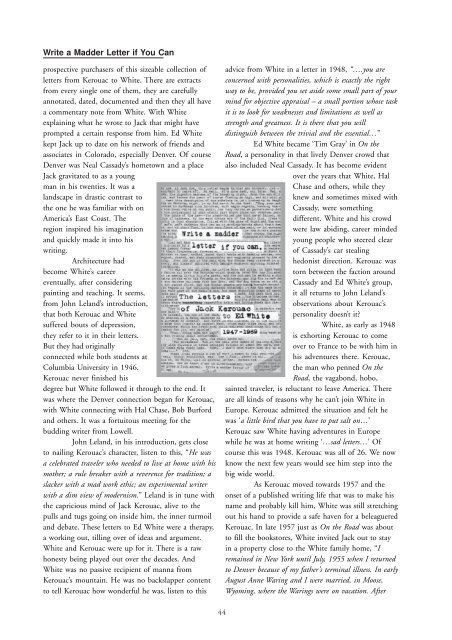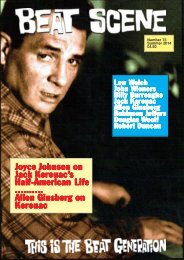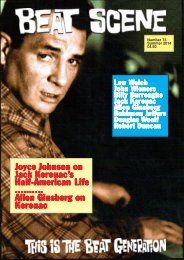Create successful ePaper yourself
Turn your PDF publications into a flip-book with our unique Google optimized e-Paper software.
Write a Madder Letter if You Can<br />
prospective purchasers of this sizeable collection of<br />
letters from Kerouac to White. There are extracts<br />
from every single one of them, they are carefully<br />
annotated, dated, documented and then they all have<br />
a commentary note from White. With White<br />
explaining what he wrote to Jack that might have<br />
prompted a certain response from him. Ed White<br />
kept Jack up to date on his network of friends and<br />
associates in Colorado, especially Denver. Of course<br />
Denver was Neal Cassady’s hometown and a place<br />
Jack gravitated to as a young<br />
man in his twenties. It was a<br />
landscape in drastic contrast to<br />
the one he was familiar with on<br />
America’s East Coast. The<br />
region inspired his imagination<br />
and quickly made it into his<br />
writing.<br />
Architecture had<br />
become White’s career<br />
eventually, after considering<br />
painting and teaching. It seems,<br />
from John Leland’s introduction,<br />
that both Kerouac and White<br />
suffered bouts of depression,<br />
they refer to it in their letters.<br />
But they had originally<br />
connected while both students at<br />
Columbia University in 1946.<br />
Kerouac never finished his<br />
degree but White followed it through to the end. It<br />
was where the Denver connection began for Kerouac,<br />
with White connecting with Hal Chase, Bob Burford<br />
and others. It was a fortuitous meeting for the<br />
budding writer from Lowell.<br />
John Leland, in his introduction, gets close<br />
to nailing Kerouac’s character, listen to this, “He was<br />
a celebrated traveler who needed to live at home with his<br />
mother; a rule breaker with a reverence for tradition; a<br />
slacker with a mad work ethic; an experimental writer<br />
with a dim view of modernism.” Leland is in tune with<br />
the capricious mind of Jack Kerouac, alive to the<br />
pulls and tugs going on inside him, the inner turmoil<br />
and debate. These letters to Ed White were a therapy,<br />
a working out, tilling over of ideas and argument.<br />
White and Kerouac were up for it. There is a raw<br />
honesty being played out over the decades. And<br />
White was no passive recipient of manna from<br />
Kerouac’s mountain. He was no backslapper content<br />
to tell Kerouac how wonderful he was, listen to this<br />
advice from White in a letter in 1948, “….you are<br />
concerned with personalities, which is exactly the right<br />
way to be, provided you set aside some small part of your<br />
mind for objective appraisal – a small portion whose task<br />
it is to look for weaknesses and limitations as well as<br />
strength and greatness. It is there that you will<br />
distinguish between the trivial and the essential…”<br />
Ed White became ‘Tim Gray’ in On the<br />
Road, a personality in that lively Denver crowd that<br />
also included Neal Cassady. It has become evident<br />
over the years that White, Hal<br />
Chase and others, while they<br />
knew and sometimes mixed with<br />
Cassady, were something<br />
different. White and his crowd<br />
were law abiding, career minded<br />
young people who steered clear<br />
of Cassady’s car stealing<br />
hedonist direction. Kerouac was<br />
torn between the faction around<br />
Cassady and Ed White’s group,<br />
it all returns to John Leland’s<br />
observations about Kerouac’s<br />
personality doesn’t it?<br />
White, as early as 1948<br />
is exhorting Kerouac to come<br />
over to France to be with him in<br />
his adventures there. Kerouac,<br />
the man who penned On the<br />
Road, the vagabond, hobo,<br />
sainted traveler, is reluctant to leave America. There<br />
are all kinds of reasons why he can’t join White in<br />
Europe. Kerouac admitted the situation and felt he<br />
was ‘a little bird that you have to put salt on…’<br />
Kerouac saw White having adventures in Europe<br />
while he was at home writing ‘…sad letters…’ Of<br />
course this was 1948. Kerouac was all of 26. We now<br />
know the next few years would see him step into the<br />
big wide world.<br />
As Kerouac moved towards 1957 and the<br />
onset of a published writing life that was to make his<br />
name and probably kill him, White was still stretching<br />
out his hand to provide a safe haven for a beleaguered<br />
Kerouac. In late 1957 just as On the Road was about<br />
to fill the bookstores, White invited Jack out to stay<br />
in a property close to the White family home, “I<br />
remained in New York until July, 1955 when I returned<br />
to Denver because of my father’s terminal illness. In early<br />
August Anne Waring and I were married, in Moose,<br />
Wyoming, where the Warings were on vacation. After<br />
44





